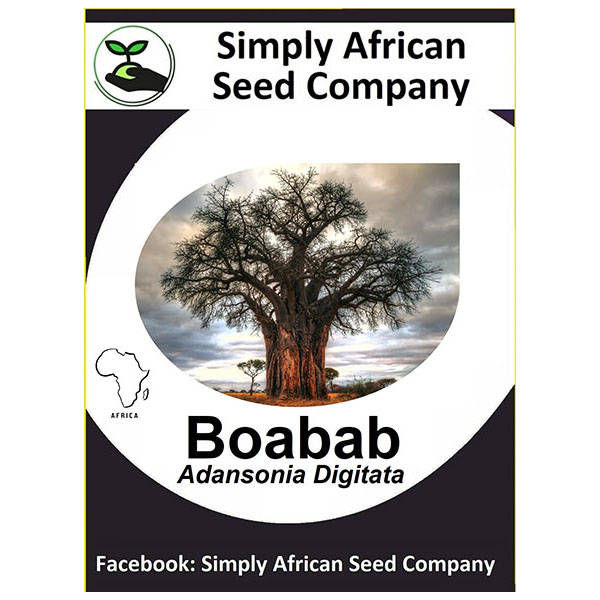



Baobab (Adansonia Digitata) Seeds
Check my rate
| Main centres: | 1-3 business days |
| Regional areas: | 3-4 business days |
| Remote areas: | 3-5 business days |




| Main centres: | 1-3 business days |
| Regional areas: | 3-4 business days |
| Remote areas: | 3-5 business days |
All Baobabs are deciduous trees ranging in height from 5 to 20 meters. The Baobab tree is a strange looking tree that grows in low-lying areas in Africa and Australia.
How long can Baobab trees live for?
Baobab trees can grow to enormous sizes and carbon dating indicates that they may live to be 3,000 years old.
One ancient hollow Baobab tree in Zimbabwe is so large that up to 40 people can shelter inside its trunk. Various Baobabs have been used as a shop, a prison, a house, a storage barn and a bus shelter. The tree is certainly very different from any other. The trunk is smooth and shiny, not at all like the bark of other trees, and it is pinkish grey or sometimes copper coloured.
When bare of leaves, the spreading branches of the Baobab tree look like roots sticking up into the air, rather as if it had been planted upside-down. Baobabs are very difficult to kill, they can be burnt, or stripped of their bark, and they will just form new bark and carry on growing.
When they do die, they simply rot from the inside and suddenly collapse, leaving a heap of fibres, which makes many people think that they don't die at all, but simply disappear.
An old Baobab tree can create its own ecosystem, as it supports the life of countless creatures, from the largest of mammals to the thousands of tiny creatures scurrying in and out of its crevices. Birds nest in its branches; baboons devour the fruit; bush babies and fruit bats drink the nectar and pollinate the flowers, and elephants have been known to chop down and consume a whole tree.
A Baby Baobab tree looks very different from its adult form and this is why the Bushmen believe that it doesn't grow like other trees, but suddenly crashes to the ground with a thump, fully grown, and then one day simply disappears. No wonder they are thought of as magic trees.
Baobab Flowers and Fruit
The Baobab tree has large whitish flowers which open at night. The Baobab fruit, which grows up to a foot long, contains tartaric acid and vitamin C and can either be sucked, or soaked in water to make a refreshing drink. They can also be roasted and ground up to make a coffee-like drink.
The fruit is not the only part of the Baobab that can be used. The bark is pounded to make rope, mats, baskets, paper and cloth; the leaves can be boiled and eaten, and glue can be made from the pollen.
Baobab Uses
Fiber from the bark is used to make rope, baskets, cloth, musical instrument strings, and waterproof hats. While stripping the bark from the lower trunk of most trees usually leads to their death, baobabs not only survive this common practice, but they regenerate new bark.
Fresh baobab leaves provide an edible vegetable similar to spinach which is also used medicinally to treat kidney and bladder disease, asthma, insect bites, and several other maladies. The tasty and nutritious fruits and seeds of several species are sought after, while pollen from the African and Australian baobabs is mixed with water to make glue.
Minimum of 6 seeds per pack
All seeds are tested and grown on our farm in Malawi and our growing area in South Africa. Please check conditions in your area for the type of seed to be grown. Growth rates and germination times are dependent on many factors such as soil conditions, rainfall/watering patterns, climate, and many more.
Growth and harvest can be affected by these conditions. Please note that certain countries require specific permission to grow certain plants or ban their growth completely. Please check your local regulations before purchasing products.
We will not be held responsible for products purchased that are not allowed in your country/province.